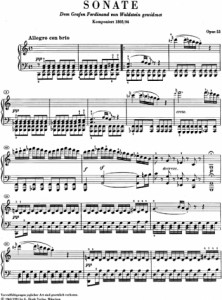 Beethoven’s Piano Sonata No. 21 in C major, Op.53, known as the “Waldstein”, is my favourite of the lot. It first came to my attention when I read Edgar Pangborn’s neglected science fiction masterpiece, A Mirror For Observers. Pangborn, a composer and pianist himself, used a performance of the piece as a key device in the plot. It remains one of the pieces I play most often.
Beethoven’s Piano Sonata No. 21 in C major, Op.53, known as the “Waldstein”, is my favourite of the lot. It first came to my attention when I read Edgar Pangborn’s neglected science fiction masterpiece, A Mirror For Observers. Pangborn, a composer and pianist himself, used a performance of the piece as a key device in the plot. It remains one of the pieces I play most often.
It starts softly, with a series of rhythmic chords devoid of melody, then plays around teasingly, until the second subject, a warm E‑major melody comes in. From there, it goes through many odd modulations, twists, and mood changes, right up to the sparkling coda (it was written in 1804, right when Beethoven was busily tossing the Classical rules out the window). The short, contemplative second movement explores every ambiguous and unclassifiable emotion you can feel.
The final movement is marked allegro moderato, and poor pianists often spoil it by playing the beginning too fast. This spoils the effect of the prestissimo finale. Andras Schiff does it right. That ending sneaks up on you like a cat, and pounces. In no other sonata does the piano sound so much like an entire orchestra: passages mimic strings, horns, tympany.The arpegios aren’t cake decorations: each one is essential to the reasoning of the piece. There is every Beethoven in it: the fist-shaking Beethoven, the sweet Beethoven, the contemplative Beethoven, the trickster Beethoven. Time and again there are moments of profound beauty, including every goddam note of the coda.
I would count this sonata as one of the very greatest piano works of all time.
0 Comments.